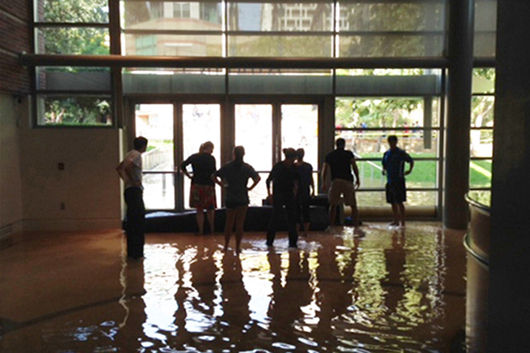
California’s Drought Calls For More Than Conservation
By Katie Francis
The devastation brought to UCLA by last week’s water main break was extensive: over 900 vehicles stranded in parking lots, at least 340 of those vehicles submerged, and the floor of Pauley Pavilion ruined by water damage. The 93-year-old pipe burst at around 3:30 p.m. on July 29, tearing a hole through Sunset Boulevard and releasing a total of 20 million gallons of potable water before LADWP employees contained the flow. Experts attributed the breakage to corrosion and aging infrastructure.
The adverse effects of the incident are intensified by its timing. In her recent interview with The Planning Report, Felicia Marcus, chair of the State Water Resources Control Board, characterizes California’s current water situation as “the worst drought emergency we’ve seen in over 100 years.” The flooding also occurred on the same day that California’s new statewide emergency water restrictions went into effect.
According to the U.S. Drought Monitor, exceptional drought – the highest of five levels on their drought intensity scale – now plagues over 58 percent of California. Governor Jerry Brown declared a drought emergency six months ago, requesting that residents voluntarily reduce their water use by 20 percent. Recently, the State Water Resources Control Board was forced to take one step further, imposing the water conservation measures that became enforceable on the day of the flood. Californians found wasting potable water for outdoor activities can now be issued fines of up to $500.
At its peak flow, Sunset Boulevard’s broken water main was discharging 75,000 gallons of water per minute. The amount of water ultimately released by the pipe was about four percent of what the City of L.A. uses each day.
Four percent is not an inconsequential amount, as Madelyn Glickfeld, director of the Water Resources Group at UCLA and member of the Regional Water Quality Control Board, has pointed out. “When the state is asking consumers to cut back by 20 percent,” Glickfeld said, “losing four percent in one day seems like a lot.”
There is no doubt in her mind that the repercussions of the water main break are intensified by the current drought situation. “A drought is not only [about] the lack of rain, but [also about] what we need to survive.” This includes drinkable water for an ever-growing population, irrigation for agriculture, and aquatic habitats to support our ecosystems.
Mark Gold, acting director of UCLA’s Institute of the Environment and Sustainability, emphasizes that the issue is two-fold: while Los Angeles is experiencing water infrastructure issues, the whole state of California is suffering a severe drought. And although the two issues represent separate concerns, they both make evident the need for improved water management.
“There’s no question that the most immediate environmental priority and infrastructural priority for the state of California is in the arena of water management,” Gold said. “We see the consequences of inadequate water management magnified today much more than in the past… It demonstrates that every time we turn on a faucet, we should really think about where that water is coming from, and what it took to get it to that faucet.”
